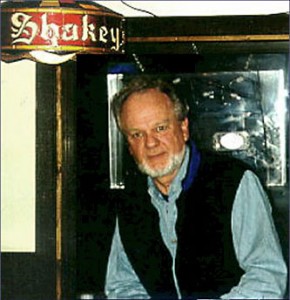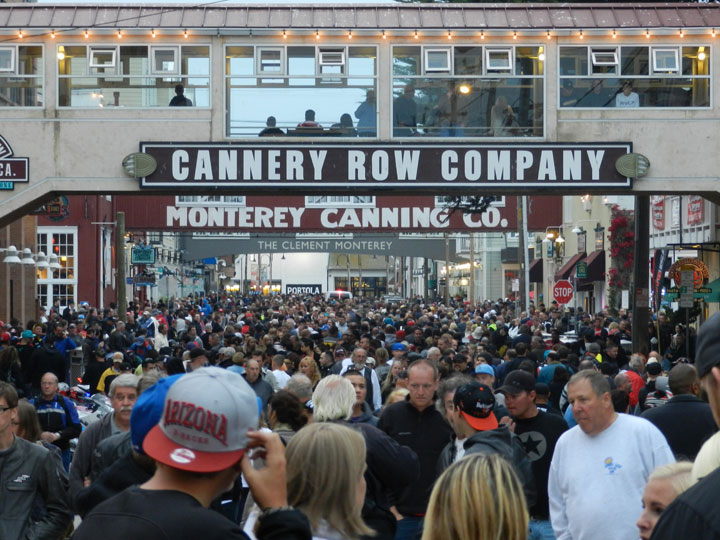Some years ago my paper on John Steinbeck, Carl Jung, the phalanx, and the Development of Higher Management Teams was published by an online forum devoted to the life and work of the Swiss psychologist and psychiatrist Carl Jung. At the time I was developing team and organization building programs for corporations. My job required some business travel. While in California I did what other Steinbeck lovers do: I took a side trip to Monterey’s Cannery Row. What follows further develops my recent post on John Steinbeck, Carl Jung, and how their insights can be applied in business.
Fellow Pilgrims to Cannery Row Discover a Mutual Interest
Sometime before my pilgrimage to Cannery Row, I received a call from James Kent (shown below), a John Steinbeck fan who also recognized the practical value of Steinbeck’s work beyond its entertaining read. He told me that he found my phalanx paper and thoughts interesting. We agreed to meet on Cannery Row to talk in person. On a walk down the hallway of our Monterey motel, Jim mentioned his concept of Gathering Place roles and how his team uses it in their initial analysis of informal network gatherings in restaurants, barbershops, and taverns in communities facing challenges. Jim and his team discovered the true nature of public attitudes and resistance within these gatherings beneath the sanitized version frequently presented by public officials. I thought the idea was brilliant and I said so.
I also thought that the concept could be applied in team analysis and building within large organizations—and I still do. This made my connection with Jim and his ideas on Cannery Row that day a particularly fortunate synchronistic experience. If one accepts Jim’s Gathering Place concept, it seems natural to me to consider its relationship to ideas expressed in John Steinbeck’s writing about the phalanx and Carl Jung’s analysis of personal and collective unconscious, functional types, and attitudes.
Steinbeck and Ricketts’ Non-Teleological Way of Thinking
To develop a personally useful understanding of phalanx, one must employ a perspective that does not require a cause-effect relationship common to some scientific research. In other words, with this non-teleological perspective the researchers eliminate the influences of hopes, fears, and expectations in their planning and study. (Please refer to the Pygmalion effect or Rosenthal effect.) Such a perspective enables the researcher to drill through the illusions and brings the subject closer to John Steinbeck’s friend Ed Ricketts’ goal of “true things.” The perspective enables increased objectivity and reduces human subjectivity, projection, and slant. Scientific psychology research has a handicap that is not an issue in other empirical sciences, and that is the study instrument (the individual human psyche) must be used to study individual human psyches. No other science has such a threat to objectivity. As a result, a non-teleological perspective is essential to psychological study objectivity.
In The Log From the Sea Of Cortez, John Steinbeck and Ed Ricketts stated the following regarding teleological and non-teleological thinking:
What we personally conceive by the term “teleological thinking,” as exemplified by the notion about the shiftless unemployed, is most frequently associated with the evaluating of causes and effects, the purposiveness of events. This kind of thinking considers changes and cures—what “should be” in the terms of an end pattern (which is often a subjective or an anthropomorphic projection); it presumes the bettering of conditions, often, unfortunately, without achieving more than a most superficial understanding of those conditions. In their sometimes intolerant refusal to face facts as they are, teleological notions may substitute a fierce but ineffectual attempt to change conditions which are assumed to be undesirable, in place of the understanding-acceptance which would pave the way for a more sensible attempt at any change which might pave the way for a more sensible attempt at any change which might still be indicated. Non-teleological ideas derive through “is” thinking, associated with natural selection as Darwin seems to have understood it. They imply depth, fundamentalism, and clarity—seeing beyond traditional or personal projections. They consider events as outgrowths and expressions rather than as results; conscious acceptance as a desideratum, and certainly as an all-important prerequisite. Non-teleological thinking concerns itself primarily not with what should be, or could be, or might be, but rather with what actually “is”—attempting at most to answer the already sufficiently difficult questions what or how, instead of why. An interesting parallel.
The powerful, unconscious, and autonomous influence on individual perception, judgment, conclusions, problem solving, decisions, and behavior, within an objective-focused gathering, group, or MOB, is what John Steinbeck called the phalanx. The MOB objective may be unreasonable or illusory, but may cause members to participate in scape-goating or group bullying of those who simply disagree with their beliefs. I believe there are few things in this life more worthy of scholarly examination than the phalanx phenomenon. The concept is based somewhat on the collective unconscious described by Carl Jung and by other philosophical giants including Harvard Professor William James, a major influence on Jung also familiar to Steinbeck, who coined the term phalanx, clearly defined it, and applied the concept in his novels.
Carl Jung’s Types and Jim Kent’s Gathering Place Roles
 Jim Kent’s Gathering Places for friends in a network are casual happenings. (John Steinbeck in Sweet Thursday: “In the Palace Flop house a little meeting occurred—occurred, because no one called it, no one planned it, and yet everyone knew what it was about.”) Informal Gathering Place roles are casually filled without formal election or appointment. I think individual styles role players gravitate naturally to their position. While I have no supportive data for this theory, I honestly believe such research would show that particular roles would naturally be filled by specific functional types—Sensation, Thinking, Intuiting, and Feeling—and attitudes: Extraverted, and Introverted. (There will be much more about the functions, attitudes, and types in my sequel to this article.) In my opinion, for example, Ed Ricketts was an “Introverted Sensation Feeling” type and as a result would fit nicely within Jim Kent’s “Caretaker” role as he specified.
Jim Kent’s Gathering Places for friends in a network are casual happenings. (John Steinbeck in Sweet Thursday: “In the Palace Flop house a little meeting occurred—occurred, because no one called it, no one planned it, and yet everyone knew what it was about.”) Informal Gathering Place roles are casually filled without formal election or appointment. I think individual styles role players gravitate naturally to their position. While I have no supportive data for this theory, I honestly believe such research would show that particular roles would naturally be filled by specific functional types—Sensation, Thinking, Intuiting, and Feeling—and attitudes: Extraverted, and Introverted. (There will be much more about the functions, attitudes, and types in my sequel to this article.) In my opinion, for example, Ed Ricketts was an “Introverted Sensation Feeling” type and as a result would fit nicely within Jim Kent’s “Caretaker” role as he specified.
Of the Introverted Sensation Type, Carl Jung said:
If there were present a capacity and readiness for expression in any way commensurate with the strength of sensation, the irrationality of this type would be extremely evident. This is the case, for instance, when the individual is a creative artist. But, since this is the exception, it usually happens that the characteristic introverted difficulty of expression also conceals his irrationality. On the contrary, he may actually stand out by the very calmness and passivity of his demeanour, or by his rational self-control. This peculiarity, which often leads the superficial judgment astray, is really due to his unrelatedness to objects.
If we include the influence of the Feeling function as an auxiliary to his Sensation type, then we are implying a strong tendency to perceive with a lean toward the interpersonal. This is my opinion based upon what information I’ve read about Ricketts. Jim’s Gathering Place roles are readily summarized and often exemplified in Steinbeck’s fiction, including Cannery Row.
Gathering Place Roles with Examples from Cannery Row
Caretakers
Are the glue that holds the culture together.
Are routinely accessible to people of the networks when they need assistance or advice.
Give assistance or advice freely; there is no chit or payback expected.
Are invisible to outsiders and do not belong to formal groups.
Are essential to high levels of social capital in society.
Ed Ricketts was a Caretaker, as is John Steinbeck’s character, the madam Flora (Fawna).
Communicators
Move information throughout the networks.
Are generally in places where they come into contact with people from various informal networks and formal groups.
Are especially prevalent in gathering places such as coffee shops, bars, beauty shops, restaurants, etc.
Are essential for moving information quickly throughout a community when you need accuracy and word-of-mouth speed.
John Steinbeck’s strike-strategist Mac is a Communicator between networks in In Dubious Battle. In Tortilla Flat Danny is a Caretaker/Communicator; Wing Chung is a Communicator.
Storytellers
Carry the culture through their stories.
Provide a community with the culture benchmarks that are essential to understand how a community can grow and still maintain the good parts of their culture.
Understand the importance of gathering places and are often the “characters” in the gathering places.
George in Of Mice and Men is a Storyteller. Of course the character Doc is cast as a Storyteller in Cannery Row, and the whole Lab actuality functions as a gathering place where stories bring understanding, introspection, reflection, and action.
Gatekeepers
Function as a protective device for the informal systems screening out intrusive people from formal systems.
Narrow the entry to a network or community through information control.
Are often verbal people who understand both the informal and the formal.
Authenticators
Function in the area of knowledge and wisdom.
Have knowledge and wisdom from the culture and often provide cultural interpretations to technical data and information generated by formal systems. Often these individuals have one foot in the cultural context and another in a scientific context understanding both as well as how to integrate so that scientific data can be put into a local context that is usable.
The Seer in Cannery Row is an Authenticator for Doc. Former Ricketts-lab key holder Eldon Dedini operates in this capacity in relation to the real-life lab and its function. Lab gathering place regular Bruce Aris was such a person, as was Ed Ricketts.
Applying the Gathering Place Concept in Your Own Group
I’d like to add my opinion that if one were to include the Jungian concept of Psychological Type to the role definitions, it may become even a more powerful tool than it is. Still, the recognition of the concept was brilliant. Think of an informal gathering of friends. Most of us would predict the likelihood that among the group are individuals filling roles as described by Jim Kent. In any network there are individuals who complement each other and other pairs who grate on each other’s nerves but tolerate the irritation for the good of the fellowship. I believe that there are gathering place role owners who, simply because of their opposing styles, may be irritants to one other. For instance, a Gatekeeper’s style may sharply contrast with that of a Communicator. A preponderance of such interpersonal connections either way will influence the social environment AND the group’s relationship to the phalanx.
Using Carl Jung’s type concept, imagine a role filled by an Introverted Intuitive Thinking type, complete with his or her grand visions, long-term plans, flow charts, logistics, cold and impersonal logic, and another role filled by an Extraverted Sensation Feeling type with interpersonal objectives, stories of previous experiences, etc. They are opposites who can either (1) let petty differences fester to the detriment of the group’s social atmosphere or (2) acknowledge that their negative emotions come out of weaknesses that are contrasted in the persona of the other individual. When this is acknowledged, the two may personally benefit from the awakening, celebrate, and value their complementary styles. The latter possibility will add to the quality of the social atmosphere and will (1) make the group less vulnerable to the negative influences of phalanx and (2) empower the network to strength far beyond its apparent resources.
Photo of James Kent courtesy Wesley Stillwagon.
This is the second in Wesley Stillwagon’s series on the application of John Steinbeck and Carl Jung’s insights in innovative corporate training program design. To be continued.




http://ekonomiuntagsmg.ac.id/callforpaper/Berita-157-analisa-rasio-keuangan-garuda-indonesia-airlines-.Html
John Steinbeck, Carl Jung, and Gathering Place Roles | Steinbeck Now